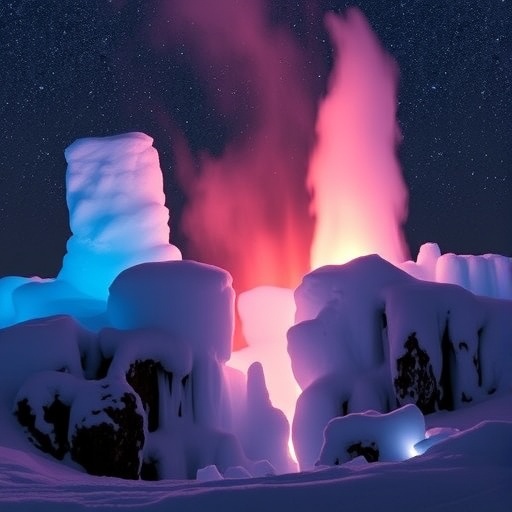In an astonishing revelation that underscores the relentless pursuit of knowledge beyond our planet, recent supercomputer simulations have generated new insights regarding Saturn’s mysterious moon, Enceladus. This icy celestial body has long fascinated scientists, largely due to its active cryovolcanic geysers that eject jets of water vapor and ice into space. As researchers continue to explore the depths of Enceladus, new findings from the Texas Advanced Computing Center (TACC) are reshaping our understanding of the moon’s ice mass loss and its implications for future exploration.
Enceladus, a frigid moon measuring a mere 313 miles in diameter, poses significant challenges when it comes to the study of its fundamental processes. Despite its diminutive size, it proves to be a powerhouse of activity, tirelessly shedding ice mass through its spirited geysers. This phenomenon is not merely a visual spectacle; it holds profound implications for our understanding of the moon’s interior and its potential to host life. The latest estimates indicate a notable reduction in the mass flow rates escaping from Enceladus, suggesting that previous literature may have significantly overestimated these values. Senior researcher Arnaud Mahieux, affiliated with the Royal Belgian Institute for Space Aeronomy and the University of Texas at Austin, highlights that the updated rates depict a reduction of 20 to 40 percent, a deviation that calls for a re-evaluation of existing models that govern our understanding of the moon’s activities.
As far back as the 17th century, early astronomers like Christiaan Huygens and Giovanni Cassini were captivated by Saturn and its remarkable rings. Yet, it wasn’t until the launch of NASA’s Cassini-Huygens mission in 2004 that humanity was granted unprecedented access to the Saturnian system, yielding a treasure trove of knowledge about its moons, with Enceladus standing out as a focal point of interest. The Cassini probe’s discovery of enormous geysers erupting from Enceladus was a pivotal moment, expanding our understanding of cryovolcanism and revealing the existence of a faint sub-ring composed of icy particles, ejected from the moon’s surface.
These groundbreaking findings prompted a wave of excitement, leading researchers to probe deeper into the mechanisms behind these eruptions. Advanced computational methods, particularly the Direct Simulation Monte Carlo (DSMC) modeling technique, have empowered scientists to simulate the dynamics governing the icy plumes. Mahieux and his colleagues harnessed the power of TACC’s supercomputers to derive parameters that dictate the behavior of these plumes, thereby revealing essential details such as exit temperature, density, and velocity—all critical for understanding Enceladus’s cryovolcanic activity.
The intricacies of the DSMC models allow scientists to emulate the interactions of particles at a molecular level, providing insights that were unattainable with previous computational methods. The ability to simulate conditions akin to those on Enceladus facilitates an in-depth exploration of the moon’s surface-to-space dynamics. By modeling the mass flow rates from various cryovolcanic sources, the research team could account for previously neglected parameters, advancing the scientific discourse on not only Enceladus but also the mechanics of icy bodies in the outer solar system.
As comparisons are drawn between the icy jets of Enceladus and terrestrial volcanic activity, it is evident that the moon’s geysers operate under vastly different conditions. While volcanoes on Earth expel molten rock, Enceladus’s cryovolcanism consists of copious amounts of water vapor and ice particles. This offers tantalizing possibilities for astrobiological research, as subsurface oceans may exist beneath its icy crust. The prospect of life beyond Earth hinges on our understanding of such environments, thus characterizing these plumes as significant portals into the mysteries hidden beneath layers of ice.
In conjunction with ongoing investigations, major space agencies like NASA and the European Space Agency are developing ambitious missions to revisit Enceladus. These proposals extend beyond mere flybys; the aim is to land on the moon’s surface and explore its icy shell for subsurface oceanic conditions. The potential for discovering signs of life in these hidden oceans is a driving force behind such missions. By analyzing the content and character of Enceladus’s plumes, researchers can glean vital information about the moon’s underwater environment without necessitating invasive drilling techniques.
The continued evolution of computational power enables researchers to ask questions previously thought unattainable. Mahieux expresses aspirations for what supercomputers can achieve in modeling celestial phenomena, envisioning advancements that could provide unprecedented levels of detail in our simulations of Enceladus and other celestial bodies. As research progresses, the critical role of institutions like TACC becomes increasingly apparent, as they provide necessary resources to support cutting-edge inquiries into our solar system’s diverse environments.
Beyond the technical innovations being harnessed in this research lies a philosophical question about the nature of life and habitable environments. By delving into subterranean oceans hidden beneath icy surfaces, scientists are not only exploring the potential for life beyond Earth but are also reflecting on the broader implications of life as a universal phenomenon. Encapsulated within the icy plumes of Enceladus is a narrative that speaks to humanity’s relentless quest for knowledge—a journey filled with the promise of discovery and understanding in the realms beyond our blue planet.
As excitement builds within the scientific community and space agencies alike, the prospect of a future filled with exploration and discovery looms large. Enhanced by state-of-the-art computational techniques and the unwavering curiosity of researchers, the secrets of Saturn’s moons, particularly Enceladus, are slowly coming to the forefront. By leveraging advancements in simulation technology alongside the pioneering spirit of exploration, we are inching closer to uncovering the truth hidden within one of the solar system’s most intriguing locations.
In summary, the ongoing investigations into Enceladus present a dynamic intersection of technology, discovery, and curiosity—an uncharted scientific frontier ripe for exploration. As researchers continue to unravel its enigmas, we stand on the brink of redefining our understanding of life, habitability, and the extraordinary nature of the cosmos present in the icy veils of distant worlds.
Subject of Research: Not applicable
Article Title: Enceladus Water Plume Modeling Using DSMC
News Publication Date: 29-Aug-2025
Web References: Journal of Geophysical Research Planets
References: Not applicable
Image Credits: Credit: NASA




